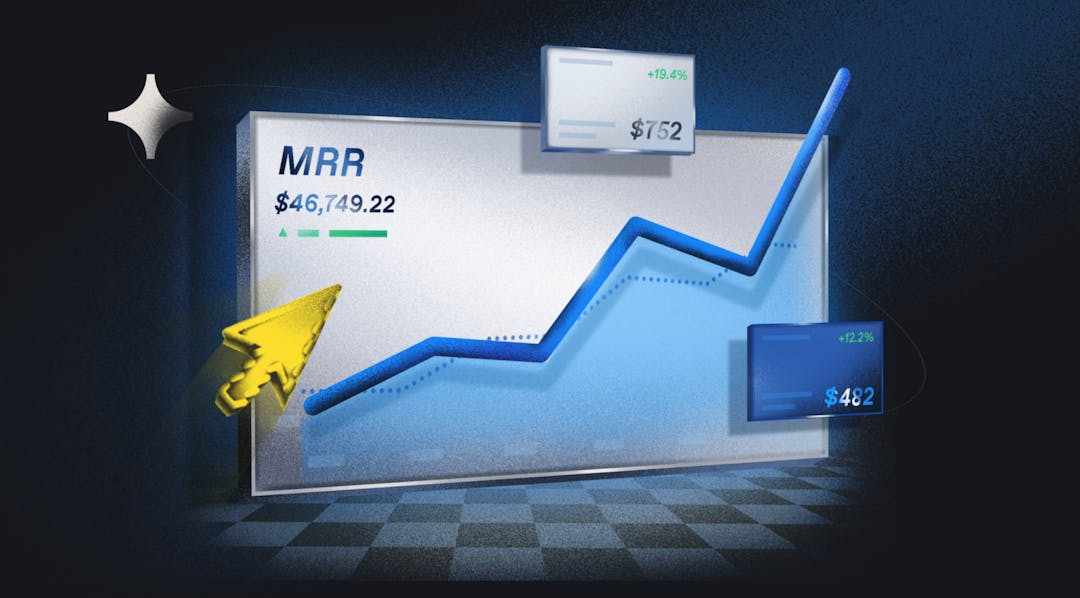Effective pricing tools should provide metrics to help identify opportunities and tools to help reduce churn, optimize pricing, and grow your subscription business. Let's explore.
Pricing isn’t about numbers; it’s about knowing.
In a fast, complex, changing world, businesses need both knowledge and flexibility in abundance when determining their pricing strategy. A business that doesn’t take a dynamic approach to its pricing won’t be able to optimize customer value and won’t stay competitive for long.
When developing a pricing strategy so that it fits these requirements, choosing the best pricing tool for your subscription business is vital. Well-thought-out pricing tools and strategies help you develop adynamic pricing environmentand manage your revenue in a way that’s sustainable and conducive to consistent growth.

What is a pricing tool?
Pricing tools help a company determine pricing options that best reflect their product’s value. The best pricing solution gives you the metrics needed to identify opportunities to grow your subscription business, optimize pricing, and, ultimately, maximize your profit margins.
The following features are standard with most pricing tools:
- Analysis of historical data to inform your pricing decisions
- Live data sets to get a broad overview of the current market
- Ability to compare products and specific features and their respective prices to gauge where your product fits
5 ways companies benefit from pricing tools
Companies that are serious about getting the best price for their product use pricing tools. The tools help business owners make short- and long-term business decisions that affect nothing less than their bottom line.
1. Staying competitive in the market
In a hyper-competitive market, getting your pricing right can make a difference when it comes to a great product that sits on the shelf versus one that flies off it. But the sheer volume of market trends and data that you’ll want to consider when determining how much to charge for your products or services is overwhelming. Choose a pricing tool that can be adjusted to find only the data you need and to present it in a way that helps you most (e.g. through visualizations, such as distribution curves). An understanding of demand and pricing elasticity is the only way to make a truly informed price-point decision. Some Excel black belts will evangelize over the Microsoft stalwart’s potential as a pricing tool. And while Excel can theoretically handle the data volume necessary for pricing, it can’t tell you much about market segmentation, product image, or distribution channels, all of which are super important to modern pricing decision-making.A good pricing tool should give you comprehensive but readable live data sets about competing price points on the market. Pricing your products just a little higher than your competitors can hurt. Pricing too conservatively can also be a drawback; we’ll get to why shortly.
2. Optimizing customer value
The right pricing tool can help you position your product correctly and offer the kind of customer service that guarantees loyalty. The two factors to consider when trying to optimize value for your customers are the positioning and the packaging of your product.PositioningPricing-tool data will help align your product to attract the right customers. Based on what your product has to offer, you may be targeting specialists or looking to attract everyone from single-person businesses all the way to big enterprises. Whatever your target, a good optimization tool will help you segment this range into buyer personas, to whom you can tailor your pricing.PackagingHaving the right feature mix in your plans is key to optimizing value for customers and ensuring future growth. Let’s say, for instance, that your company is like Hubstaff, with a product that appeals to a wide range of customer types in several industries. In such an instance, tailor your packaging to specific kinds of users, so that customers can get the most value out of your product relative to the field they’re working in. A good pricing tool can give you the sort of pricing intelligence that’ll stop you from making customer-value-optimization mistakes, too. If certain features are flagged as free in your competitors’ products, then you know not to bundle similar features into a premium-priced option.
3. Maximizing profit margins
Pricing strategy is not a case of “lowest price wins” but of “highest value wins.” Strange though it seems, “value” is often overlooked in pricing strategy. Without first assessing the state of the market and the value your product is capable of providing, you risk short-selling yourself and sacrificing profit margins. A good pricing tool shows a product’s true value and provides a basis for a price-optimization plan relative to that. For example, you don’t want to be lowering your base price to match a competitor’s rate if your product is stocked with many more features, loaded with a much higher appeal across different industries, backed up by a much more solid support system, etc. If your product is of much greater “value” than your competitor’s product, it should be priced to reflect that value.For example, by understanding customers’ willingness to pay (WTP) for common product features, you can find opportunities to improve your margin. Consider this value matrix, again for Hubstaff:
All features have different scores relative to both value (the utility they provide to a customer) and willingness to pay (how much the customer-base recognizes that value). If your time-management product features all of those high-value/high-WTP features, then you shouldn’t be setting the product cost lower than a competitor that includes just one of those features. Think of the lost revenue!A well-used pricing tool reveals the real value of your product. If your product is of higher value, you can consider whether or not you should actually be raising your price point to maximize your profit relative to product value.
4. Improved knowledge of buyer personas
Accurate pricing cannot be done without an accurate understanding of buyer personas, and a poor understanding of buyer personas is what makes scaling and growth difficult for SaaS companies.
This is the degree to which a SaaS company should be looking to quantify their buyer personas.
A pricing tool that gives you a greater handle on your buyer personas will not only help you increase your revenues but also potentially improve your company in other areas. Unquantified buyer personas often lead to haphazard approaches to testing and product improvement, ineffective application of data analysis, and even failure to properly diagnose monetization problems when they crop up. Even if you already have some rudimentary ideas of your buyer personas, data from a good pricing tool will allow you to establish the following:
- Willingness to pay
- Features they do and don’t find important in a product
- Where your buyer personas can be found (localization is a key consideration of pricing strategy that is often overlooked)
- Estimated Lifetime Value as well as Customer Acquisition Costs
All of these aspects of buyer personas are essential to setting pricing points that are well-aimed and feasible.
5. Better road-mapping
The data that can be harvested by a pricing tool is not just useful for immediate decision-making — it can play an important role in planning for future, improved iterations of your product. For instance, once you know the relationship between features of your product and your buyer personas, you can develop an even sharper idea of willingness to pay, and your positioning approach. Certain features may be a hit with some segments and a miss with others, so plan appropriately. Likewise, if certain features will lead to a higher overall WTP for your product or have an ongoing value that increases your user retention, you can adjust your pricing. For instance, you might move low WTP features into different pricing tiers, increasing the price on deals containing popular features that no other competitor is bringing. Pricing tools are all about enabling your decision-making to be more dynamic: If the data is telling you that a competitor’s product has a feature that yours doesn’t, consider incorporating a version of this feature into your next update.
The best pricing tool for your subscription business
What you should not do is look at pricing-tool data uncritically or presume that what is shown to be working for another company or industry is also likely to work for you. Certain companies will stay competitive in their market by using cost-plus pricing; in others, tiered pricing will be the best bet. The data is the only thing that knows the answer for sure.
Nevertheless, even being armed with the best knowledge doesn’t change the fact that there has never been a more difficult time to grow a subscription business than now.
When the difference between the right price point and the wrong one is so slim, it pays to have a pricing tool able to split the difference. Paddle’s Price Intelligently program combines pricing data and industry-leading expertise into a pricing tool capable of doing just that.
Price localization
Even in a global market like SaaS, a buyer’s location is one of the most under appreciated pieces of information when developing buyer personas. Localization of pricing can bring in a revenue lift of between 11% and 18%. Accurate localization is one of the ways in which Price Intelligently enables you to capture that extra growth while maintaining customer satisfaction.
Personas and market-mapping
The importance of buyer personas can’t be stressed enough, and neither can the difficulty of establishing exactly what yours are.
With Price Intelligently, you can build a clear picture of your buyer personas and learn in clear detail who you should be targeting based on a huge number of compared price points. This pricing tool gives key insights into the WTP/value matrix we looked at earlier and can point you toward which features and value propositions in your product drive the most value.
Data-driven road maps
You should be able to rely on your pricing-tool data to drive your ongoing development and boost your retention analysis. Price Intelligently will give you in-depth information on popular features of your product in certain customer segments and tell you which features will drive retention and which are drawing high WTP.
Pricing audit
Once you’ve got a pricing strategy that works, the pricing tool will be able to tell you what’s working particularly well and what can be improved upon.
Price Intelligently helps you determine which parts of your brand are winning you customers in the market and where your win-rate stands versus that of your competitors. It gives you a direct means of monitoring the amplification of your brand.
The pricing solution’s right
Given the amount of work that goes into making a great product with unique features, it’s tempting to think that once you’ve hit upon the right formula, success is almost a formality. Unfortunately, in a marketplace as competitive as today’s, a great product is only half the battle.
That’s why dynamic pricing environments play such an important role in your business’s success. With so many great products in competition with yours, knowing where the pricing sweet spot lies is decisive. The right pricing tool will point you to it.



